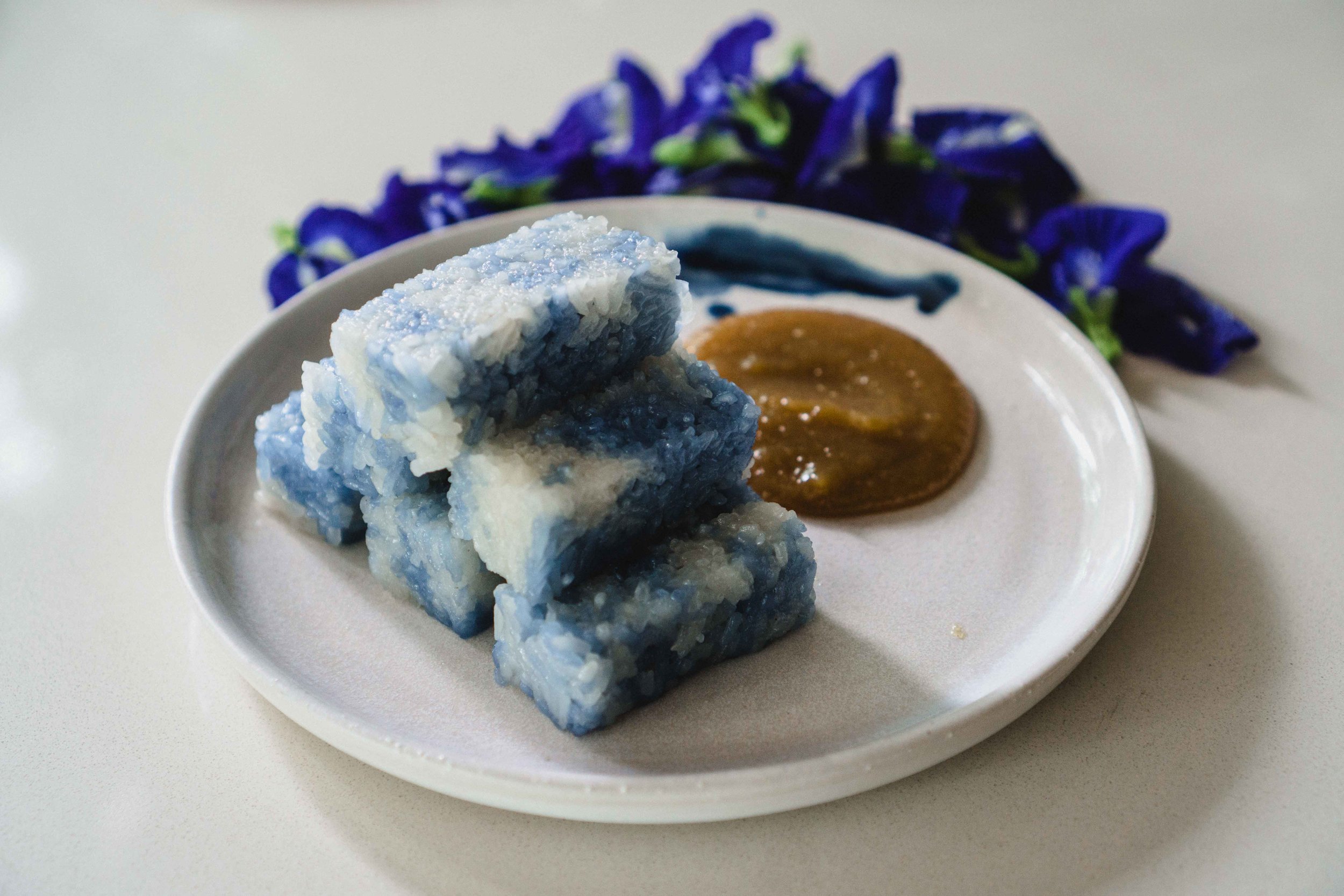Pulut Tai Tai (a.k.a. Rich Auntie Rice Cakes..?)
I’ve been sitting on this recipe for the longest time, trying to build a compelling post around it. It’s just one of those things that deserve a bit more attention y’know, not least because one of the ingredients in this particular recipe has a certain significance in my life (not necessarily in a good way...). So then a few months passed and I still don’t have much of a narrative for it. But on the plane ride home from Melbourne a few weeks back, I was hit by an unexpected burst of creativity and ended up writing a silly poem within the first hour of boarding. What!? A poem!? I know, totally unprecedented. I don't know what came over me either. Before we get to the poem though (which I'm sure you can't wait to read and laugh at my lack of poetic sense), you'll need a bit of context.
The recipe in question is for Pulut Tai Tai. It’s a sweet glutinous rice cake that is a staple in Peranakan cuisine, often eaten with a dollop of kaya (or many dollops if you’re anything like me). I'm not entirely sure about the etymology behind the name, but as far as I know, pulut is glutinous rice and tai tai is cantonese for rich married woman/auntie, which means Pulut Tai Tai = glutinous rice for rich aunties..? Hmm... In all honesty though, this pulut dish would be considered pretty unremarkable if not for the marbled streaks of blue running through the rice. After all, blue is a very rare colour in the world of food. (Just try naming another blue food/ingredient!)
Traditionally, the cobalt blue for Pulut Tai Tai is extracted from butterfly pea flowers, which look like mini-orchids crossed with a certain female part (hint: its species name is Clitoria Ternatae). They’re not the easiest flower to source, even in South-East Asia, but luckily for me, mom planted some across the road several months ago, and they’ve been blooming non-stop ever since. It’s borderline annoying really. You spend a good half hour harvest them all one day, pat yourself on the back for a job well done, and then more pop up the very next day in a clear act of defiance. Silly flowers.
So yes, this poem is about those flowers. I might look back at this in ten years and cringe so so hard, but this seems like a good idea right now, so what the hell.
- - -
Poem Tai Tai
Blue flowers.
Those brazenly blue flowers.
Fifty, a hundred, two hundred of them.
Speckled on the three bushes across the road
like Pollock spilled blue paint.
Blue flowers,
Oh they’re so nice, pick them before they go away,
It’d be such a waste,
mom says.
Blue flowers.
They’re butterfly pea flowers (Wikipedia tells me),
also clitoria something or other, because they look like clits.
Blue flowers,
I mean butterfly clit pea flowers,
I should know what they’re called now,
since I picked them the other day.
Fifty, a hundred, two hundred of them.
They came back the very next day.
Jun, go pick them again,
mom says.
- - -
Wow. Didn’t know I had that much angst in me.
Moving swiftly on, let's talk recipe. The method itself is dead simple - you soak some rice, stir in the colour from the flower, steam it, mix it. Done-o. Not much of a story there. Plus, you could technically do without the colour as it only lends colour not flavour. This is not to discount how good it can taste though! Warm it up, dunk it in some good ol' kaya (coconut jam), and bam you’ve got a Nyonya party in your mouth. Go make some!
- - -
Pulut Tai Tai
makes ~30 pieces, serves 4
Ingredients
500g glutinous rice
200g coconut milk
~200g water, to cover rice
2 pandan leaves, optional
20 butterfly pea flowers, optional (as it only lends colour not flavour)
20g sugar
2g salt
200g kaya (coconut jam), or more. Store-bought ones are generally good, but if you want to make it from scratch, here's my recipe for pandan kaya.
Method
- Butterfly pea extract (if using fresh flowers): Wash flowers well, then put them into a small saucepan along with ~50ml of water, bring to the boil, let cool for 10 minutes, then strain to get blue extract.
- Rinse glutinous rice in cold water until water runs clear. Then soak for 4-6 hours, or overnight.
- Strain out the rice and discard the water, then separate rice into two (non-perforated) steaming baskets/bowls/trays. Add the blue dye to one of the portions of rice.
- Then, add an equal amount of coconut milk into both portions of rice, and add water to both until the rice is barely covered.
- Place pandan leaves on top, then steam for 30-40 minutes, until cooked through (but not mushy!).
- Now add the blue rice to the white rice and mix very roughly to get a somewhat marbled effect. Then, place the mixed rice into a square tray and press down to compact it. (You can use gloves or a strong spatula to compress the rice so it doesn’t stick to your hand.)
- Let it cool slightly, then cut it into whatever shape you fancy. Rectangles are the retro, minimal-waste way (see photos above).
- Serve it with a dollop of kaya, and let the Nyonya party begin.







